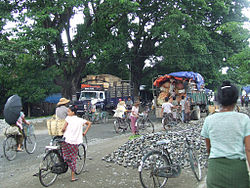Kalewa | |
|---|---|
Town | |
 | |
| Coordinates: 23°12′48″N94°19′06″E / 23.21333°N 94.31833°E | |
| Country | |
| Division | |
| District | Kale |
| Township | Kale Township |
| Time zone | UTC+06:30 (MST) |
Kalewa is a town at the confluence of the Chindwin River and the Myittha River in Kale District, Sagaing Region of north-western Myanmar. It is the administrative seat of Kalewa Township.



